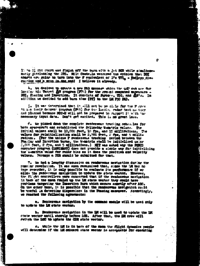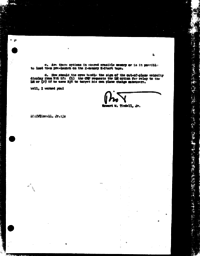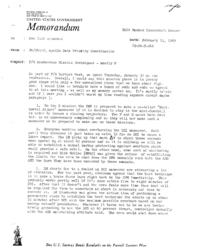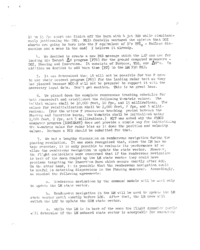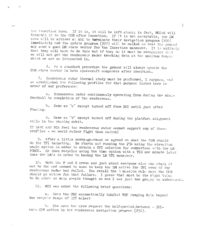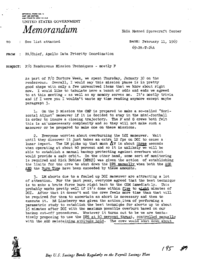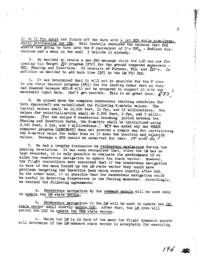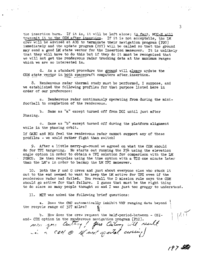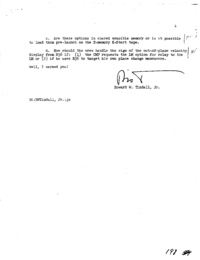See list attachedFebruary 11, 196969-PA-T-24APA/Chief, Apollo Data Priority CoordinationF/G Rendezvous Mission Techniques – mostly F
As part of F/G Torture Week, we spent Thursday, January 30 on the rendezvous. Overall, I would say this mission phase is in pretty good shape with only a few unresolved items that we know about right now. I would like to tabulate here a bunch of odds and ends we agreed to at this meeting – as well as my memory serves me. It's mostly trivia and if I were you I wouldn't waste my time reading anymore except maybe paragraph 3.
1. On the D mission the CMP is prepared to make a so-called “Hori- zontal Adjust” maneuver if it is decided to stay in the mini-football in order to insure a closing trajectory. The F and G crews both felt this is an unnecessary complexity and so they will not make such a maneuver or be prepared to make one on these missions.
2. Everyone worries about overburning the LOI maneuver. Wait until they discover it just takes an extra 12 fps on DOI to cause a lunar impact. The LM picks up that much ΔV in about three seconds when operating at about 40 percent and so it is unlikely we will be able to establish a manual backup protecting against overburn which would provide a safe orbit. On the other hand, some sort of monitoring is required and Rick Nobles (MPAD) was given the action of establishing the limits for the crew to shut down the DPS manually when both the AGS AND the Burn Time have been exceeded by these amounts.
3. LM aborts due to a fouled up DOI maneuver are attracting a lot of attention. For the past year, everyone agreed that the best technique is to make a brute force burn right back to the CSM immediately. This probably works pretty well if it's done within five to eight minutes of DOI. After that it doesn't and the crew feels more time than that will be required for them to ascertain an abort is necessary and then to execute it. Ed Lineberry was given the action item of performing a parametric study to establish the best technique for aborts up to about 15 minutes after DOI with the maximum possible overburn based on our backup cut-off procedures. Whatever it turns out to be we are tenta- tively proposing to use the DPS at 40 percent thrust, controlled manually with the AGS maintaining attitude hold. The crew would shut down about 10 to 15 fps short and finish off the burn with 4 jet RCS while simultane- ously jettisoning the DPS. Milt Contella ventured the opinion that DOI aborts are going to turn into the F equivalent of D's TPI₀ – Endless dis- cussion and a mess in the end! I believe it already.
4. We decided to create a new PAD message which the CMP can use for loading his Target ΔV program (P76) for the ground computed maneuvers – DOI, Phasing and Insertion. It consists of Purpose, TIG, and ΔV's. In addition we decided to add burn time (BT) to the LM P30 PAD.
5. It was determined that it will not be possible for the F crew to use their descent program (P63) for the landing radar test as they had planned because MCC-H will not be prepared to support it with the necessary input data. Don't get excited. This is no great loss.
6. We pinned down the complete rendezvous tracking schedules for both spacecraft and established the following W-matrix values. The initial values shall be 10,000 feet, 10 fps, and 15 milliradians. The values for reinitialization shall be 2,000 feet, 2 fps, and 5 milli- radians. (For the unique F rendezvous tracking period between the Phasing and Insertion burns, the W-matrix shall be initialized using 2,000 feet, 2 fps, and 5 milliradians.) MIT was asked why the PGNCS computer program (LUMINARY) does not provide a simple way for initializing the W-matrix value for radar bias as it does the position and velocity values. Perhaps a PCR should be submitted for that.
7. We had a lengthy discussion on rendezvous navigation during the phasing revolution. It was soon recognized that, since the LM has no tape recorder, it is only possible to evaluate its performance if we allow the rendezvous navigation to update the state vector. However, the flight controllers were concerned that if the rendezvous navigation in back of the moon fouled up the LM state vector they could have problems targeting the Insertion Burn which occurs shortly after AOS. On the other hand, it is possible that the rendezvous navigation could be useful in detecting dispersions in the Phasing maneuver. Accordingly, we reached the following agreements:
a. Rendezvous navigation by the command module will be used only to update the LM state vector.
b. Rendezvous navigation in the LM will be used to update the LM state vector until shortly before LOS. After that, the LM crew will switch the LGC to update the CSM state vector.
c. While the LM is in back of the moon the flight dynamics people will determine if the LM onboard state vector is acceptable for executing the insertion burn. If it is, it will be left alone; in fact, MCC-H will transmit it to the CSM after insertion. If it is not acceptable, the LM crew will be advised at AOS to terminate their navigation program (P20) immediately and the update program (P27) will be called so that the ground may send a good LM state vector for the Insertion maneuver. It is unlikely that they will have to do this but if they do it must be recognized that we will not get the rendezvous radar tracking data at the maximum ranges which we are so interested in.
d. As a standard procedure the ground will always update the CSM state vector in both spacecraft computers after insertion.
8. Rendezvous radar thermal study must be performed, I suppose, and we established the following profiles for that purpose listed here in order of our preference:
a. Rendezvous radar continuously operating from during the mini- football to completion of the rendezvous.
b. Same as “a” except turned off from DOI until just after Phasing.
c. Same as “b” except turned off during the platform alignment while in the phasing orbit.
If GAEC and RCA feel the rendezvous radar cannot support any of these profiles – we would rather fight than switch!
9. After a little merry-go-round we agreed on what the CSM should do for TPI targeting. He starts out running the P34 using the elevation angle option in order to obtain a TPI solution for comparison with the LM PGNCS. He then recycles using the time option with a TIG one minute later than the LM's in order to backup the LM TPI maneuver.
10. Both the F and G crews and just about everyone else who stuck it out to the end seemed to want to keep the LM active for TPI even if the rendezvous radar had failed. You recall the D mission rule says the CSM should go active for that failure. I guess that must be the right thing to do since so many people thought so and I was just too groggy to understand.
11. MIT was asked the following brief questions:
a. Does the CMC automatically inhibit VHF ranging data beyond the recycle range of 327 miles?
b. How does the crew request the half-period-between – CSI– and- CDH option in the rendezvous navigation program (P32).
c. Are these options in shared erasable memory or is it possible to load them pre-launch on the E-memory K-Start tape.
d. How should the crew handle the sign of the out-of-plane velocity display from R36 if: (1) the CMP requests the LM option for relay to the LM or (2) if he uses R36 to target his own plane change maneuvers.
Well, I warned you!
- Sep 24, 1969 – Apollo 12 Mission Techniques (4.0σ)


